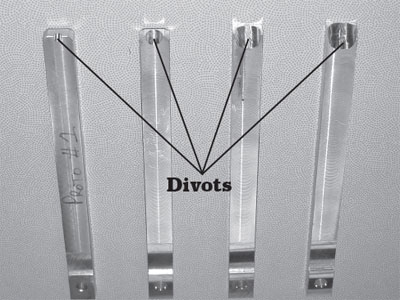
Gary Kees, Project Leader
Brad Campbell, Project Assistant
- Single-seed planters allow tree seeds to be
planted where they're most likely to thrive
and at a depth that increases the
likelihood of germination.
- The Missoula Technology and
Development Center (MTDC) tested the
effectiveness of four single-seed planters.
- Of the planters tested, the Hatfield Transplanter Model 1.5 and the Stand 'n Plant were t he easiest to use, although both could be strengthened to hold up better in field use.
Tools Evaluated
The Missoula Technology and Development Center (MTDC) purchased four commercially available planters to evaluate their effectiveness for planting tree seeds of varying sizes. We tested the planters in previously prepared seedbeds at the Forest Service's Coeur d'Alene Nursery and at MTDC in an area closely mimicking a typical forest-floor environment. The tools tested (figure 1) were the:
- Almaco Hand Jab Standard-Style Planter ($270)—designed for seeds
- Seed Stick Planter ($99)—designed for seeds
- Stand 'n Plant Planter ($40)—designed for seeds, bulbs, and sprouts
- Hatfield Transplanter Model 1.5 ($119)—designed for plugs, seeds, tubers, and bulbs

Figure 1—Planters tested were, from left to
right, Almaco Hand Jab, Seed Stick, Stand 'n
Plant, and Hatfield Transplanter.
All of the planters except the Seed Stick have a hollow stem or tube with a simple bit to penetrate the soil. When these tools are pushed or jabbed into soil, the operator drops a seed into the hollow tube. The bit's trapdoor design allows the seed to be deposited in the soil. The Stand 'n Plant has a cord mounted near the top, which the operator squeezes to separate the bit and allow the seed to drop into the soil. The operator of the Hatfield Transplanter pulls the handles apart and stabs the ground (figure 2). The operator squeezes the planter's handles together (figure 3) to open the bit, releasing the seed. The Almaco Hand Jab's bit opens when the operator pushes the tool to the side (figure 4). Both the Hatfield Transplanter and the Almaco can be adjusted to plant seeds at different depths.

Figure 2—The Hatfield Transplanter's
handles are open when the operator
stabs the Hatfield Transplanter into
the ground and steps on the foot plate.

Figure 3—After the Hatfield
Transplanter's bit penetrates
the soil, the
operator drops
a seed, plug, or bulb into
the hollow tube, and squeezes
the
planter's handles together,
releasing the seed at the
proper depth.

Figure 4—The operator stabs the Almaco
Hand Jab into the ground and
drops
a seed into the hollow tube. To release
the seed, the operator pushes
the
Almaco to the side on its "foot,"
opening the bit.
The Seed Stick (figure 5) mounts on a long push broom-style handle with a seed hopper near the ground. A spring-mounted ram removes a seed from the hopper and drops it into the hollow tube. Another spring-operated ram pushes the seed to the proper depth as the operator pushes the tool into the ground. The planter came with three rams to accommodate different sizes of seed. MTDC fabricated a fourth ram to handle the tiny seeds of Douglas-fir trees (figure 6).

Figure 5—As the Seed Stick is pushed
into the soil, a ram is pushed into the
seed hopper, lifting a seed and dropping
it into the hollow tube. When the
operator
makes a final push, the seed goes through
the bit and into the soil.

Figure 6—Different sizes of rams used for the Seed Stick.
Each ram has a
divot cut at its top to accommodate the
seed.
The ram must be changed for
seeds of different sizes.
The ram on the left was fabricated by the MTDC
machine
shop to accommodate tiny Douglas-fir seeds.
We evaluated all four planters at the Coeur d'Alene nursery and at MTDC using whitebark pine, lodgepole pine, and Douglas-fir seeds.
It's easier to plant seeds in raised nursery beds than in most field settings. The Almaco Hand Jab, Stand 'n Plant, and Hatfield Transplanter placed seeds at the desired depth, up to 2 inches deep, in nursery beds. When the Seed Stick was used, the planting depth was inconsistent, and it was difficult to determine whether a seed had actually been placed in the soil.
A pine grove at MTDC provided a more realistic setting for testing the planters (figure 7). For all of the planters except the Seed Stick, seed size did not matter. Seed size was a factor for the Seed Stick because the ram that picks seed from the hopper and places it in the soil must be closely matched to the seed size.

Figure 7—The Hatfield Transplanter was
tested in a pine grove at MTDC.
We scraped the ground with our boots, removing loose organic matter, before we tested the planters. When we used a strong jab to push the Almaco Hand Jab, Stand 'n Plant, and Hatfield Transplanter planters into the soil, the planters' bits were at the proper depth for planting. The seed was dropped by hand down the tube and the seeder was lifted from the soil following the manufacturer's instructions. All of these planters left a divot with the seed easily seen in the ground (figure 8). Soil displaced by the planter was brushed over the seed and tamped by foot, minimizing the air space around the seed.

Figure 8—Whitebark pine seeds were painted
red so they could be seen during
testing.
The seeds are shown in a hole made by
the Almaco Hand Jab.
The Almaco Hand Jab, Stand 'n Plant, and Hatfield Transplanter hollow-tube planters worked best, planting seed at the desired depth. The Stand 'n Plant was easy to use and provided consistent results. Durability may be an issue with this planter, and it can be difficult to plant the seeds deep enough. The planter's durability could be improved by fabricating a metal bit and strengthening the bit's release mechanism.
The Almaco Hand Jab and Hatfield Transplanter can be used to plant small seedlings as well as seeds, although we did not plant any seedlings during these tests. The Hatfield Transplanter was the easiest planter to use, and the handle height and seed depth could be adjusted easily. The Hatfield Transplanter's durability could be improved by strengthening its bit and footplate.
Vendor Information
Seedburo Equipment Co.
(Almaco Hand Jab Standard-Style Planter)
2293 South Mt. Prospect Rd.
Des Plaines, IL 60018
Web site: http://www.seedburo.com/
Phone: 800–284–5779
Fax: 312–738–5329
Stand 'n Plant
(Stand 'n Plant Planter)
95 Rose Rd.
Saltsburg, PA 15681
Web site: http://www.standnplant.com/
Phone: 724–349–5167
Johnny's Selected Seeds
(Hatfield Transplanter Model 1.5 and Seed Stick Planter)
955 Benton Ave.
Winslow, ME 04901
Web site: http://www.johnnyseeds.com
Phone: 877–564–6697
Fax: 800–738–6314
Gary Kees joined MTDC in 2002 as a project leader. He works in the reforestation and nursery, forest health, facilities, fire, and GPS programs. His current projects involve ATV and backpack sprayers, nursery equipment, fuel cans, and air quality. Kees, who has a degree in mechanical engineering from the University of Idaho, worked for 10 years as a mechanical and structural engineer, project manager, and engineering group leader for Monsanto Co. in Soda Springs, ID.
Brad Campbell worked at MTDC on a detail as part of the Federal Executive Leadership Program. He has a bachelor's degree in geology from Western Washington University and a master's degree in geological engineering from the University of Nevada, Reno. Campbell worked in State and private industry for 10 years before joining the U.S. Department of the Interior, Bureau of Reclamation.
For additional information about single-seed direct planters, contact MTDC:
Phone: 406–329–3900
Fax: 406–329–3719
Electronic copies of MTDCs documents are available on the Internet at:
http://www.fs.fed.us/t-d
http://www.fs.fed.us/eng/pubs
Forest Service and Bureau of Land Management employees can search a more complete collection of MTDC's documents, CDs, DVDs, and videos on their internal computer networks at:

